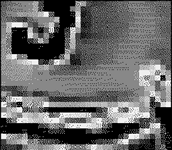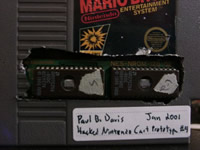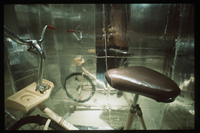06.04.2001
Opening June 16th! 8:00
PM
BEIGE Presents: **** "Post-Data in the Age of Low Potential"
****
Opening lecture/performance by The 8-Bit Construction Set (Beige
Records)
on data aesthetics. Learn how to crack software, why
Macromedia sucks, and
come watch Beige gain an advantage over other
computer users through
Post-Data computational craft.


[showing:]
1. "Urbandale", an ASCII/ANSI movie by
Cory Arcangel
"Filmed at Urbandale Plaza in the eastern suburbs of
Buffalo N.Y.,
"urbandale" is a study of America's suburban sprawl
stripped to its barest
essentials and void of unnecessary contemporary
cultural influence. This
film captures the sly, bland smile strip
plazas cast at modern culture.
The film, rendered in text, focuses on
the repetitive motion of food
stuffs being cooked in the lobby of a
discount department store."
"Urbandale" is a 2000 commission of New Radio and Performing Arts,
Inc.,
dba Ether-Ore, for its Turbulence project. It was made possible
with
funding from the Jerome Foundation.
[Stills from Urbandale manually screenprinted by PINC]
2. "Fat Bits", 8-bit Nintendo Movies and Screenprints by Cory
Arcangel
and Paul B. Davis. Looping real-time animations generated from
re-programmed
8-Bit Nintendo cartidges with multichannel
soundtracks
"Bereft of a veneer, interaction with such complicated
machinery
requires a significant amount of technological knowledge and
awareness. In
this spirit, "Fat Bits" represents a step towards what
Cory and I describe
as "Post-Data". We create computer art which is
aesthetically aware of both
its own identity and the underlying process
which supports it - that is to
say it recognizes the fundamental
prototype of the "computer", and not the
"software", as the tool and
medium. The content for "Fat Bits", video of a
NHL hockey fight, was
chosen because the close-up nature of its imagery
makes for convenient
replication on low-resolution systems such as the
Nintendo
Entertainment System. The use of the Nintendo Entertainment System
is
itself important because it, firstly, signifies an
artistic
"re-licensing" of proprietary corporate technology and,
secondly, refutes
Nintendo's forced obsolescence profit structure which
defines it as
"outdated" (the Nintendo Entertainment System was
introduced to the US home
video game market in 1986).
Our primary
foundation of Post Data is then this: the conscious
corruption of data,
the releasing of bits from their imprisonment within
the restrictive,
limiting boundaries of corporate software applications,
and the
exploitation of the extreme complexity of computer systems paired
with
the extreme intentionality of artist(s) who seek to engage
the
computing process at a fundamental level. It is at this point that
the
machine "speaks" to us, revealing a more honest representation of
the
technological extremity. In an effort to make the communication of
such a
bit state, the Post Data movement often refers to such
unfettered bits as
"fat," expressing their newly acquired ability to
realize and release their
heretofore potentialities. Thus, the ultimate
goal of the Post Data
movement becomes harnessing this fat potential
and applying it in ways that
can only be innovative - hence, "Fat
Bits." "
[Stills from Fat Bits manually screenprinted by Paul B. Davis]
3. "Hasselhoff", letterpress prints by Paul B. Davis
A collection of
small format hand set letterpress images which represent
an offshoot of
bitmap/ASCII art in the form of "ornamental portraiture".
The portraits
in this case being of everyone's favorite 3rd rate television
star -
David Hasselhoff.
BEIGE is an electronic music recording company and computer
programming
ensemble.
http://www.beigerecords.com
Upcoming:
June 8, NYC, 8-Bit Construction Set lecture
June 9,
NYC, 8-Bit Construction Set live performance
June 16th-23rd, Chicago,
Beige gallery exhibition
Also... Cool group of
folks releasing a virus at the Venice Biennale on Monday.
Check out
their site. It's pretty rockin' (great t-shirts too)...
A
Virus in the Venice Biennale
A group of artists and programmers will
exhibit a new computer virus.
A virus
is usually considered evil, chaos. But what happens when it is
a
contemporary art temple to spread the chaos?
Conceived and
compiled for the invitation to the 49th Venice Biennale,
"biennale.py"
is the product of the collaboration of two
entities,
0100101110101101.ORG and epidemiC, already known for other
shocking
actions, often bordering with crime. "biennale.py" is both a
work of art
and a computer virus.
The source code of the virus will
be made public and spread on the
opening day of the Biennale, June 6th
2001, from the Slovenian Pavilion.
The main anti-virus software
companies have already been informed about
the technical specifications
of "bienale.py" and the disinstallation
instructions will be attached
to the virus.
03.06.2001
Opening this
Friday!
Check out Jeff Shore
and Jon Fisher's great work "Ride Like the Wind"
Awesome
interactive installation just coming back from a run in New York and
headed to New Orleans. more...

02.24.2001
Trevor's show is still kickin' so come on
by.
Also get ready for Jeff Shore's
installation Ride Like the Wind, with sound by Jon Fisher opening at DEADTECH on the 9th.
also the EVE 5 crew at
UIC is rockin...
EVE 5
Exhibition
Hours: March 1, Opening Reception
5:30-9:00PM March 2-3,
10:00AM-8:00PM
Curated by Dan Sandin, Drew Browning and Franz
Fischnaller; School of Art and Design, University of Illinois at Chicago.
A provocative exhibit of virtual reality-based artworks, EVE 5
features the independent works of twelve artists experimenting with sound,
interaction and exploration.
Sponsored by the Electronic
Visualization Laboratory at the University of Illinois at Chicago (UIC),
this Electronic Visualization Event is the fifth in a series since 1975
showcasing computer-generated artwork, interactive installations and live
performance. EVE 5 will expand upon this legacy to feature sound works,
conceptual landscapes and interactive narratives, which unfold as
participants make decisions at critical junctures to determine the
outcome.
The work will run continuously in the CAVEŽ, a room-sized
virtual-reality theater. EVL, longtime pioneers of electronic artwork and
display devices, reached a milestone in 1992 with its debut of the CAVE,
an advanced system that is now commercially available, and used globally
for art, design and scientific discovery.
For more information, see http://www.evl.uic.edu/EVE5
also... the Ontario College of
Art and Design's Sumo
Robot competition draws
near...
02.05.2001
Opening Friday Feb 9th!
3
works by Trevor Paglen!
Landscape No. 1,
Endgame, and Synthetic Rainstorm
internet enabled audio
and audio/video installations
Trevor Paglen's show opens this
friday.
so come drink some beer and check it out!
When: This Friday
Feb 9th
Time: Opening at 9:00 PM til 1:00 or so AM
Where: DEADTECH
3321 W. Fullerton Ave Chicago IL
773-395-2844
Press Release with the full scoop below...
Sound Art gets a Face-Lift: Deadtech hosts Trevor Paglen's
Innovative Sound Installations Chicago, IL.
Deadtech will host a
show from Feb. 9th to Mar. 4th featuring the work of Trevor Paglen; an
Oakland, CA based sound artist, composer and performer.
The
opening for the show will be held at 9pm on Feb. 9th. Trevor Paglen will
be presenting 3 new works entitled Landscape No. 1, Endgame, and Synthetic
Rainstorm.
Trevor Paglen is a critically acclaimed sound artist
whose work has been shown internationally. He describes himself as being
against what he sees as the 'formalist obsessions' of his sound
colleagues. Paglen defines his own work as exploring 'the realm of
acoustic signification and spatial practice,' and as a 'dialectical
negation of image with sound.'
Trevor Paglen's Landscape No. 1 is
a video/sound installation consisting of a 3-minute video loop, where the
soundscape of the video completely changes every time the video loops.
Landscape No. 1 explores what Paglen calls the 'acoustic ecology' of an
urban supermarket, highlighting through sound the various forces at work
in urban space.
Endgame, a second installation featured at
Deadtech, utilizes streaming audio from the Internet as raw source
material for aural sculpture. The installation is controlled by a software
engine which streams random 'world music' from the Internet in real time.
These real-time streams can be heard through a pair of headphones. Once
the music is streaming, it is shuttled to a different computer and
processed utilizing an algorithm developed by the artist. This process
creates an ambient soundscape, where variations are created by changes in
the streamed music. The unchanging processing algorithm ensures a coherent
form to the processed audio.
In the stairwell at Deadtech will be
Trevor Paglen's Synthetic Rainstorm, a particularly postmodern
recollection of Magritte's "this is not a pipe/apple/hat" paintings.
Through the magic of digital audio, Trevor Paglen has created a larger,
louder, clearer, and more violent rainstorm than is found in nature. The
experience of Synthetic Rainstorm lies somewhere between simulated ecstasy
and relativistic horror.
With the Trevor Paglen exhibition,
Deadtech, celebrates it's 10th show.
opening will run 9 PM till 1 AM or so... so come on
by...
hours
and directions if ya need em.
also tons of stuff coming
up...
01.15.2001
First post of
the new year. Cool stuff going on here at the warehouse.
8pm Tuesday (01.16.2001)
The K and D posse has
asked us
to play co-host to DIY-fest here in Chicago and we, of course,
happily obliged.
Chicago represents with improvisational
audiovisuals by Justin C. Rounds (digital audio/video synthesis) and Josh
Bartos (turntables).
Various other crazy stuff is going down as
well.
Check the DIY-fest site
for more info.
Lots more upcoming stuff
planned for the year... Stay tuned!